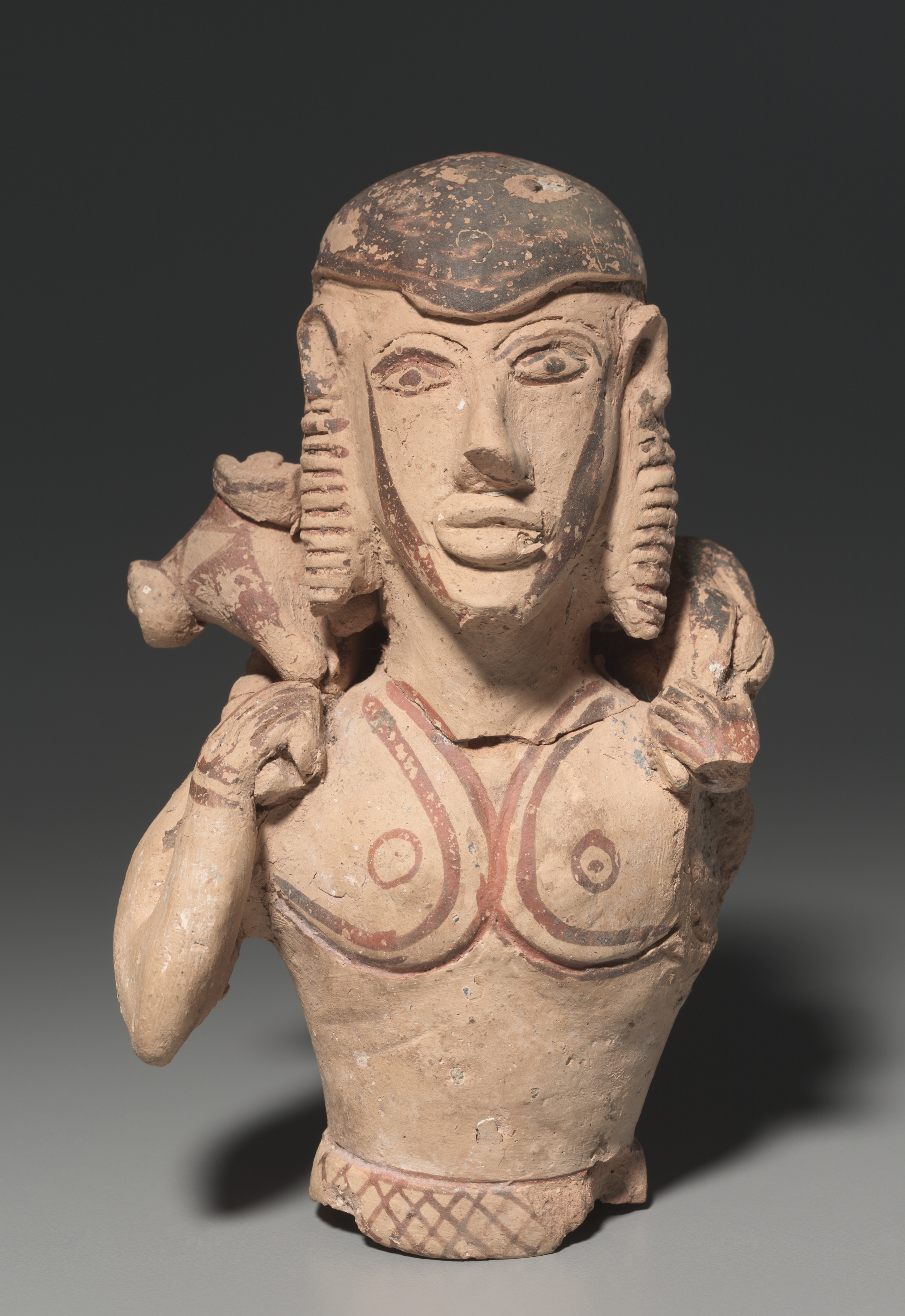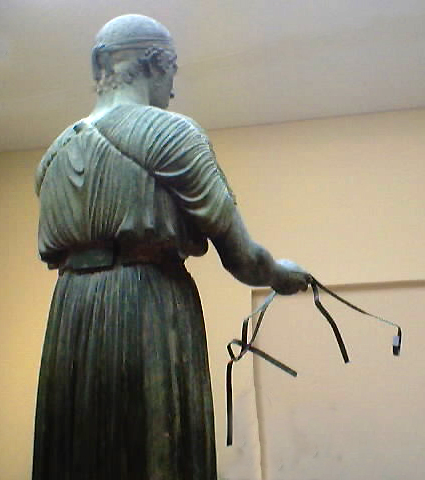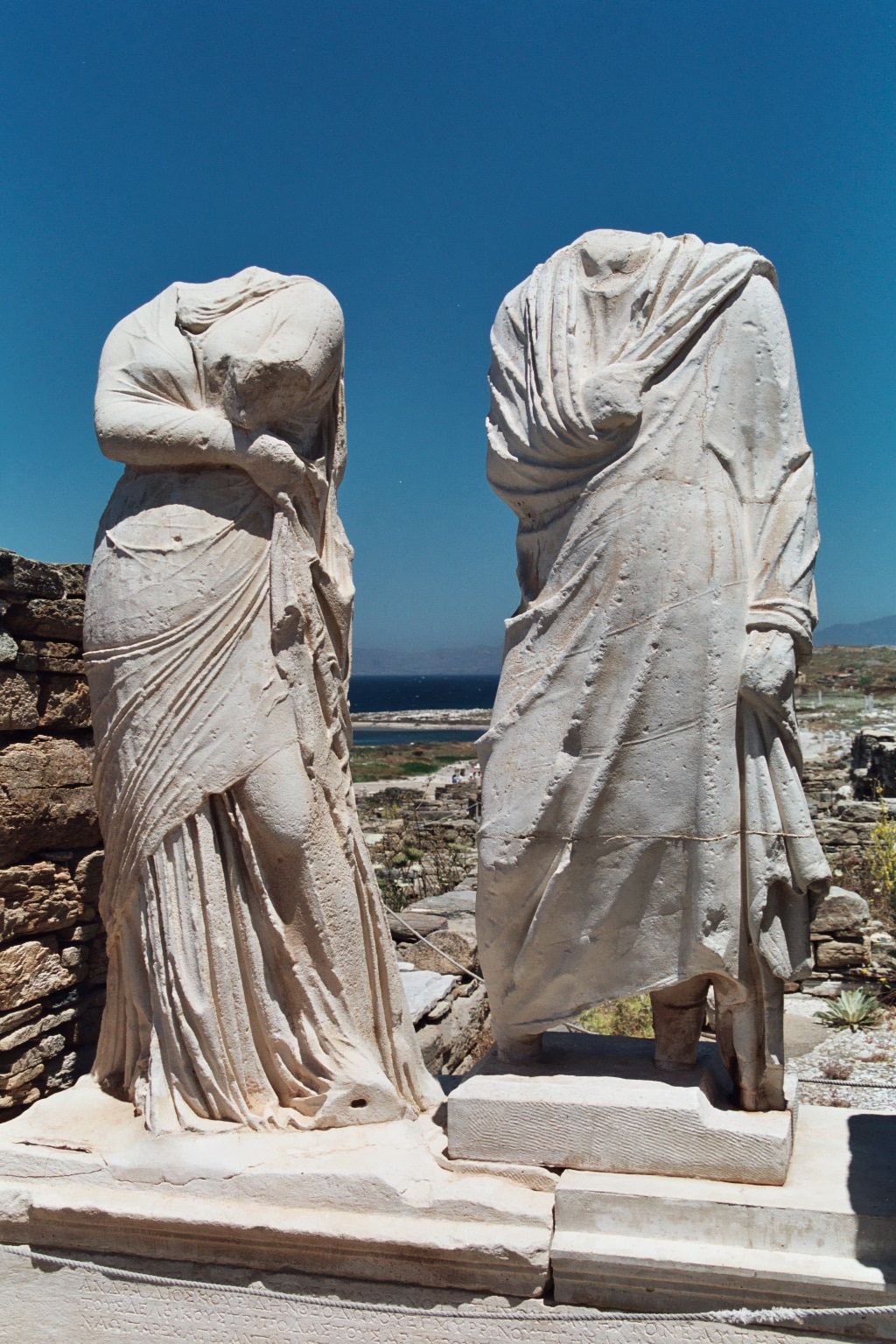|
Zoster (costume)
A zoster ( el, ζωστήρ, ''zōstēr'') was a form of girdle or belt worn by men and perhaps later by women in ancient Greece, from the Archaic period (c. 750 – c. 500 BC) to the Hellenistic period (323–30 BC). The word occurs in Homer, where it appears to refer to a warrior's belt of leather, possibly covered in bronze plates. Later references in the late Archaic and early Classical periods show it used as a belt or cloth girdle with men's clothes, especially the shorter ''chiton''. By the Hellenistic period, it had become synonymous with "zone" and was used for women's clothes as well as men's. The zoster was also worn and is still worn by Greeks when wearing traditional costumes (regional clothing). See also *Clothing in ancient Greece Clothing in ancient Greece primarily consisted of the chiton, peplos, himation, and chlamys. Ancient Greek civilians typically wore two pieces of clothing draped about the body: an undergarment ( : chitōn or : péplos) and a ... [...More Info...] [...Related Items...] OR: [Wikipedia] [Google] [Baidu] |
Ancient Greece
Ancient Greece ( el, Ἑλλάς, Hellás) was a northeastern Mediterranean civilization, existing from the Greek Dark Ages of the 12th–9th centuries BC to the end of classical antiquity ( AD 600), that comprised a loose collection of culturally and linguistically related city-states and other territories. Most of these regions were officially unified only once, for 13 years, under Alexander the Great's empire from 336 to 323 BC (though this excludes a number of Greek city-states free from Alexander's jurisdiction in the western Mediterranean, around the Black Sea, Cyprus, and Cyrenaica). In Western history, the era of classical antiquity was immediately followed by the Early Middle Ages and the Byzantine period. Roughly three centuries after the Late Bronze Age collapse of Mycenaean Greece, Greek urban poleis began to form in the 8th century BC, ushering in the Archaic period and the colonization of the Mediterranean Basin. This was followed by the age of Classical G ... [...More Info...] [...Related Items...] OR: [Wikipedia] [Google] [Baidu] |
Archaic Period In Greece
Archaic Greece was the period in Greek history lasting from circa 800 BC to the second Persian invasion of Greece in 480 BC, following the Greek Dark Ages and succeeded by the Classical period. In the archaic period, Greeks settled across the Mediterranean and the Black Seas, as far as Marseille in the west and Trapezus (Trebizond) in the east; and by the end of the archaic period, they were part of a trade network that spanned the entire Mediterranean. The archaic period began with a massive increase in the Greek population and of significant changes that rendered the Greek world at the end of the 8th century entirely unrecognisable from its beginning. According to Anthony Snodgrass, the archaic period was bounded by two revolutions in the Greek world. It began with a "structural revolution" that "drew the political map of the Greek world" and established the ''poleis'', the distinctively Greek city-states, and it ended with the intellectual revolution of the Classical period. ... [...More Info...] [...Related Items...] OR: [Wikipedia] [Google] [Baidu] |
Hellenistic Period
In Classical antiquity, the Hellenistic period covers the time in Mediterranean history after Classical Greece, between the death of Alexander the Great in 323 BC and the emergence of the Roman Empire, as signified by the Battle of Actium in 31 BC and the conquest of Ptolemaic Egypt the following year. The Ancient Greek word ''Hellas'' (, ''Hellás'') was gradually recognized as the name for Greece, from which the word ''Hellenistic'' was derived. "Hellenistic" is distinguished from "Hellenic" in that the latter refers to Greece itself, while the former encompasses all ancient territories under Greek influence, in particular the East after the conquests of Alexander the Great. After the Macedonian invasion of the Achaemenid Empire in 330 BC and its disintegration shortly after, the Hellenistic kingdoms were established throughout south-west Asia ( Seleucid Empire, Kingdom of Pergamon), north-east Africa ( Ptolemaic Kingdom) and South Asia ( Greco-Bactrian Kingdom, Indo-Greek ... [...More Info...] [...Related Items...] OR: [Wikipedia] [Google] [Baidu] |
Homer
Homer (; grc, Ὅμηρος , ''Hómēros'') (born ) was a Greek poet who is credited as the author of the ''Iliad'' and the ''Odyssey'', two epic poems that are foundational works of ancient Greek literature. Homer is considered one of the most revered and influential authors in history. Homer's ''Iliad'' centers on a quarrel between King Agamemnon and the warrior Achilles during the last year of the Trojan War. The ''Odyssey'' chronicles the ten-year journey of Odysseus, king of Ithaca, back to his home after the fall of Troy. The poems are in Homeric Greek, also known as Epic Greek, a literary language which shows a mixture of features of the Ionic and Aeolic dialects from different centuries; the predominant influence is Eastern Ionic. Most researchers believe that the poems were originally transmitted orally. Homer's epic poems shaped aspects of ancient Greek culture and education, fostering ideals of heroism, glory, and honor. To Plato, Homer was simply the one who ... [...More Info...] [...Related Items...] OR: [Wikipedia] [Google] [Baidu] |
Chiton (costume)
A chiton (Greek: χιτών, ''khitōn'') is a form of tunic that fastens at the shoulder, worn by men and women of ancient Greece and Rome. There are two forms of chiton. One is the Doric chiton and the later Ionic chiton. According to Herodotus, popular legend was that Athenian women began to wear the chiton as opposed to the peplos after several women stabbed a messenger to death with the bronze pins characteristic of the peplos. Etymology The word ''chiton'' is derived from a Central Semitic language *''kittan'' (e.g. Hebrew כֻּתֹּנֶת ''kuttṓnĕṯ''), ultimately from a word for flax. Different forms and wearing styles A shorter version of the chiton was called the chitoniskos. Doric chiton The Doric chiton is a single rectangle of woolen or linen fabric. It can be worn plain or with an overfold called an ''apoptygma'', which is more common to women. It can be draped and fastened at the shoulder by pins (Greek: peronai; Latin: fibulae) or sewing, or by button ... [...More Info...] [...Related Items...] OR: [Wikipedia] [Google] [Baidu] |
Zone (vestment)
The zone ( el, ζώνη, ''zōnē'') is a form of girdle or belt common in the ancient eastern Mediterranean. The term occurs in Homer, for instance, as ( el, ζώνην, ''zonēn'') girdle and can also refer to the waist itself. Classical Greek had a verb ( el, ζώννυσθαι, ''zōnnysthai'') put a girdle around the loins, or "gird one's self." In modern Greek and Church Slavonic the zone or (Поясъ, ''poyas'' - ''belt'') is a liturgical belt worn as a vestment by priests and bishops of the Eastern Orthodox Church, Oriental Orthodox Churches and Eastern Catholic Churches. It is made of brocade with an embroidered or appliquéd cross in the center, with long ribbons at the ends for tying around the waist. It is worn over the sticharion and the epitrachelion and keeps them in place as the priest performs the Divine Liturgy. In this regard it is similar to the cincture of the Roman Catholic Church. The zone is not worn for services when the priest is not fully ves ... [...More Info...] [...Related Items...] OR: [Wikipedia] [Google] [Baidu] |
Clothing In Ancient Greece
Clothing in ancient Greece primarily consisted of the chiton, peplos, himation, and chlamys. Ancient Greek civilians typically wore two pieces of clothing draped about the body: an undergarment ( : chitōn or : péplos) and a cloak ( : himátion or : chlamýs). Ancient Greek clothing was mainly based on necessity, function, materials, and protection rather than identity. Thus, clothes were quite simple, draped, loose-fitting and free-flowing. Customarily, clothing was homemade and cut to various lengths of rectangular linen or wool fabric with minimal cutting or sewing, and secured with ornamental clasps or pins, and a belt, or girdle (: zōnē). Pieces were generally interchangeable between men and women.Adkins, Lesley, and Roy Adkins. ''Handbook to Life in Ancient Greece.'' New York: Facts On File, 1997. Print. However, women usually wore their robes to their ankles while men generally wore theirs to their knees depending on the occasion and circumstance. While no clothes ... [...More Info...] [...Related Items...] OR: [Wikipedia] [Google] [Baidu] |
Belts (clothing)
Belt may refer to: Apparel * Belt (clothing), a leather or fabric band worn around the waist * Championship belt, a type of trophy used primarily in combat sports * Colored belts, such as a black belt or red belt, worn by martial arts practitioners to signify rank in the kyū ranking system Geology * A synonym for orogen (e.g. orogenic belt) * Greenstone belt * A large-scale linear or curved array of belt of igneous rocks (e.g. Transscandinavian Igneous Belt) * A large-scale linear or curved array of mineral deposits (e.g. Bolivian tin belt) * Metamorphic belt :* Paired metamorphic belts Mechanical and vehicular * Belt (mechanical), a looped strip of material used to link multiple rotating shafts * Conveyor belt, a device for transporting goods along a fixed track * Belt manlift, a device for moving people between floors in a building or grain elevator. * Seat belt, a safety device in automobiles and on the plane * Timing belt, part of an internal combustion engine * Serpenti ... [...More Info...] [...Related Items...] OR: [Wikipedia] [Google] [Baidu] |

.jpg)


_-_Homer_and_his_Guide_(1874).jpg)


